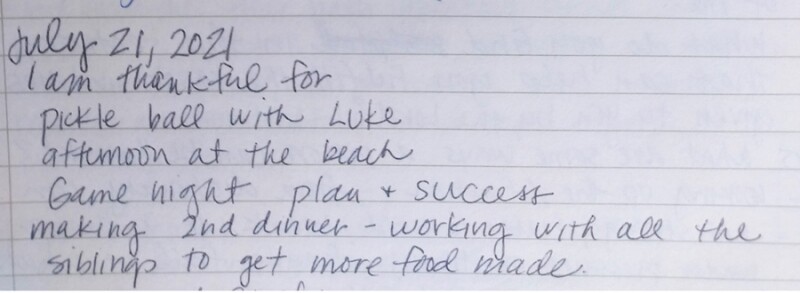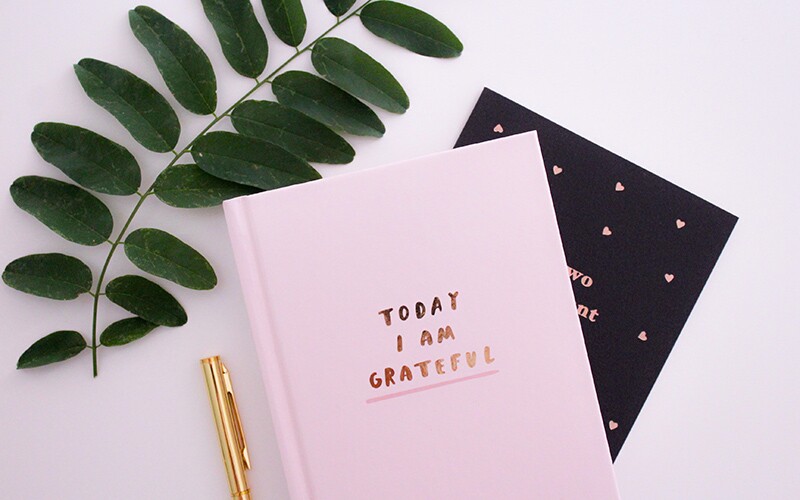Last summer, Camille Johnson was struggling. Her mother was dying, and the pandemic was raging. “I decided I needed to do something,” she recalls. “I didn’t have any energy; I wanted to sleep all the time.”
“Then I remembered about a character in a book who was going through a depression,” she continues. “Her dad challenged her to write a thank-you note to someone every week. I started researching how gratitude can help us.” Camille was so impressed by her findings that she dedicated an entire episode of her podcast to gratitude—and began keeping a gratitude journal.
Two months later, she reflected on the benefits of this practice on her social media account. “It has been such a fun thing to look at my day and see things that I appreciate. Even when I forget for a few days, I enjoy looking back, catching up and thinking about all the things … that I was grateful for.”
Camille, who lives in Ohio, United States, has now been keeping a gratitude journal for a year. “I write in it at least once a week. It takes me less than five minutes, and it puts me in a good frame of mind for the day.”
What Is a Gratitude Journal?
A gratitude journal is where people record things they’re thankful for. Entries might be written out in paragraph form, but many are simple lists, like Camille’s entry from 21 July 2021:

What sets gratitude journals apart from other kinds of personal records is that the content focuses specifically—even exclusively—on expressing appreciation.
What Are the Benefits of a Gratitude Journal?
As Camille researched gratefulness, she was impressed by its psychological and emotional power. “I learned that if you start having more gratitude and start writing it down, you start training your brain to find more things to be grateful about,” she explains. “This can help us overcome our natural negativity bias,” which is an instinctive tendency to dwell on negative things.
“Keeping a gratitude journal has helped my brain make an effort to look out for things I’m grateful for,” Camille reflects. “When I notice something, I think, ‘I’ll have to write this down.’ Now, even when things feel hard or heavy, I am able to find something I am grateful for, like my favorite ice cream. It buoys me up. There were a couple of days after my mom died that I just had to be grateful for a good cry.”

Scientific research supports Camille’s experience. Gratitude is associated with a better quality of life, more positive emotions, and healthy social activity. Being grateful can lower symptoms of stress, anxiety, and depression. Gratefulness is even tied to a healthier resting heart rate, better heart and immune function, improved sleep quality, lowered blood pressure, and fewer physical symptoms overall. People who keep gratitude journals specifically have been shown to exercise more, make more progress toward their goals, and feel more optimistic about their lives.
How to Start a Gratitude Journal
When starting a gratitude journal, keep it simple. “At the beginning, I’d just write a couple of bullet points,” recalls Camille. “Something that happened that day that I was grateful for. You can always find one thing—or maybe three things—you’re thankful for.” For the most powerful experience, experts say, focus on specific things you appreciate in that moment—not “my children” but, more specifically, “the sound of my son’s laughter,” for example.
Figuring out how journaling would fit into Camille’s life required experimentation. “I started writing every day, but sometimes I’d forget, so I’d catch up throughout the week,” she recalls. (As it turns out, writing one to three times a week rather than daily can actually be more impactful for some people.) “At first, I’d take five minutes at night, but I was too tired, so I started doing it more in the morning, when I have more time to reflect.” She paired her habit with an existing one so she’d remember it. For her, it was scripture study, but others may enjoy journaling after a walk or run, during a meditation, or while making a to-do list.

What about the format of a gratitude journal? “I started in Google Drive, but sometimes it would be hard to get out my computer or do it on my phone, so I started using a journal,” she says. What’s important is choosing a format you’ll stick with, whether that’s an app, notebook, day planner, diary, or electronic document.
If it would help to have some support when you start a gratitude journal, consider inviting a friend or relative to start one, too. You might search online for a gratitude challenge or explore gratitude groups on your favorite social media platform.
How Can a Gratitude Journal Fit into Your Life Story?
“I haven’t been good at keeping a regular history of my life, but gratitude journal entries are a snapshot of my life,” reflects Camille. “They bring back the rest of my memories of that day.” Paired with photos, her memories become even more vivid, like this family reunion photo that illustrates her entry about “working with all the siblings to get more food made.” (Camille is third from the right, in the white shirt.)

“Looking back this way gives me a broader view of my life,” she adds. “I don’t necessarily think everything is positive and happy, but I can see more clearly that things are working together for my good.” She likes the idea of leaving this kind of written legacy for her five children. “I think I would rather have them know me as someone who was grateful for a handful of things every day, instead of a person who was whining about a handful of things every day!”
Start Your Own Gratitude Journal
How could a gratitude journal work for you? Try it yourself! Start recording lists of things you appreciate in a notebook or electronically. Or capture your gratitude lists with the FamilySearch Memories app.











